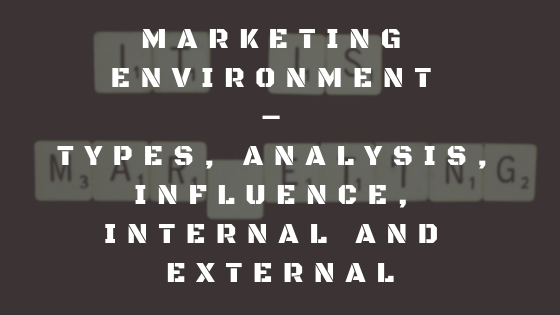Marketing environment study and analysis are the key factors to the success of any organization. Companies who ignored this have passed through the difficult time in past. In this article, we are going to understand the types of the marketing environment, reasons to study and its influences.
Types of Marketing Environment
Companies interact with two kinds of the environment which are microenvironment and macroenvironment.
The microenvironment can be classified into internal environment and external environment.
Internal environment consists of firms management structure, i.e., organization strategies, objectives & departments within the company and internal characteristics which can affect its ability to serve its customers.
External environment consists suppliers, marketing intermediaries, customers, competitors and public shareholders. Public shareholders may include local interest groups which concern about marketers impact on the environment or a local employment.
Macro environment consists of broader forces that affect demand for companies goods; these numbers may include demographics, economics, nature, technology, politics, and culture.
Why do we analyze Market environment?
It is essential to take an outside-inside view of your business to be a successful organization. You need to recognize that the marketing environment is always presenting new opportunities and threats. Successful companies also realize the importance of continuously monitoring and adapting to the environment.
A company that has consistently reinvented one of its brands to keep up with changing marketing environment is “Mattel” with its “Barbie doll.” Many businesses fail to see the change as a prospect. They ignore or resist changes until it is too late. Their strategies, structures, systems and organizational culture grow increasingly obsolete and dysfunctional.
Corporations as mighty as Nokia, General Motors, IBM, and Sears have passed through a difficult time because they ignored macro environmental changes.
Hence it can be concluded that successful companies used to recognize and respond efficiently towards environmental needs and trends.
Reasons for studying Market Environment.
It is vital to study internal and external environment of the market to assess strength, weaknesses, opportunities, and threats presented by marketing environment.
Why consider internal environment?
The internal environment is the environment prevailing within the organization. It is an organizational environment regarding its
- Business resources like brands, product features and product lines, competitive advantage, core competencies.
- Infrastructures like men, machine, methods, materials, and money
- Relationships with stakeholders regarding business.
Internal environment study helps us in realizing organizational capabilities concerning the performance of different business functions. It directs towards analysis of strength and weakness within an organization.
Strong areas or power of an agency may help to explore long-term advantage in the market. Analysis of the weak regions or deficiencies may assist in realizing their marketing objectives accordingly.
Why study external environment?
External business conditions comprise of favorable events and unfavorable events. Desirable events if adequately explored can result in leading a successful business.
Hostile circumstances if not efficiently managed may pose tough times for the organizations. Scanning of external environment may lead to the exploration of opportunities and threats.
Opportunities may help a group taking advantage of the external environment. Research of risks supports an organization to construct and implement a plan to safeguard their business interest.
The primary purpose of environmental scanning is to recognize new marketing opportunities. The marketing opportunity is an area of a buyer need or potential interest in which a company can perform profitably. Chances can be in many forms and marketers must have an ability to spot them.
Influence of Marketing Environment
Marketing environment may affect various factors including wants, primary and secondary research, consumer behavior, demand for goods, SWOT, types of products, etc.
- Wants will be influenced by levels of economic prosperity, social and cultural factors.
- Macro environment issues will be critical areas for firms to do primary and secondary research.
- Technological, economic, social and cultural factors may influence consumer behavior.
- Economic, political, technological factors may affect demand for goods.
- Types of products developed by the organization will have to take into account with the micro and macro environment.
- Economic factors may determine which markets are more profit giving than others. Low levels of commercial success are not always bad for growth, for example in developing countries degree of local competition may be low.
- The changing macro environment may influence strengths/weaknesses, opportunities, threats faced by an organization.

